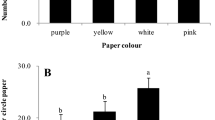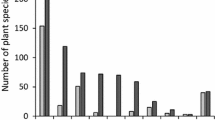Abstract
Common blossom thrips, Frankliniella schultzei Trybom (Thysanoptera: Thripidae), feed on pollen and flower tissues. They use multiple host species, but are regularly found in abundance on only some, with the red-flowered Malvaviscus arboreus the primary host in South-East Queensland. Flower-feeding insects commonly use plant odours and colour to recognise their usual hosts, so we quantified the attraction of flying thrips, in the field, to M. arboreus flowers relative to those of a secondary host (Hibiscus rosasinensis). More than two-thirds of the thrips were attracted to H. rosasinensis flowers over those of M. arboreus in a field test. We also compared flowers of these species in a cage, where significantly more thrips approached H. rosasinensis flowers than M. arboreus ones, and in an olfactometer, where significantly more approached the blank than flowers and leaves of either species. Thrips also avoided flower extracts in small arena-based studies. These thrips are clearly, but unexpectedly, more likely to approach the non-ancestral secondary host H. rosasinensis than their primary host plant M. arboreus (with which they presumably evolved), and are repelled by leaf and flower odours of both species. We propose that F. schultzei uses mainly vision in host recognition, and the hummingbird-pollinated M. arboreus has evolved insect-repellent properties. Residence times and oviposition rates in flowers across the two host species now warrant testing.


Similar content being viewed by others
References
Abdullah ZS, Ficken KJ, Greenfield BPJ, Butt TM (2014) Innate responses to putative ancestral hosts: is the attraction of western flower thrips to pine pollen a result of relict olfactory receptors? J Chem Ecol 40:534–540
Ballantyne G, Wilmer P (2012) Nectar theft and floral ant-repellence: a link between nectar volume and ant repellent traits? PLoS ONE 7:e43869
Braglia L, Bruna S, Lanteri S, Mercuri A, Portis E (2010) An AFLP-based assessment of the genetic diversity within Hibiscus rosa-sinensis and its place within the Hibiscus genus complex. Sci Hortic-Amsterdam 23:372–378
Briscoe AD, Chittka L (2001) The evolution of colour vision in insects. Annu Rev Entomol 46:471–510
Bruce TJA, Wadhams LJ, Woodcock CM (2005) Insect host location: a volatile situation. Trends Plant Sci 10:269–274
Cardoso CJF, Gonzaga MO, Cavalleri A, Maruyama PK, Alves-Silva E (2016) The role of floral structure and biotic factors in determining the occurrence of florivorous thrips in a dystilous shrub. Arthropod-Plant Interact 10:477–484
Cronk Q, Ojeda I (2008) Bird pollinated flowers in an evolutionary and molecular context. J Exp Bot 59:715–727
Delphia CM, Mescher MC, De Moraes CM (2007) Induction of plant volatiles by herbivores with different feeding habits and the effects of induced defenses on host-plant selection by thrips. J Chem Ecol 33:997–1012
Hereward JP, Hutchinson JA, McCulloch GA, Silva R, Walter GH (in press) Divergence among generalist herbivores: the Frankliniella schultzei species complex in Australia (Thysanoptera: Thripidae). Arthropod-Plant Interact. http://doi.org/10.1007/s11829-017-9543-3
Jermy T (1984) Evolution of insect/host plant relationships. Am Nat 124:609–630
Jones LC, Foster BJ, Rafter MA, Walter GH (in press) Tiny insects against the weather—Flight and foraging patterns of Frankliniella schultzei (Thripidae) not altered by onset of rainfall. Insect Sci
Kakkar G, Seal DR, Stansly PA, Liburd OE, Kumar V (2012) Abundance of Frankliniella schultzei (Thysanoptera: Thripidae) in flowers on major vegetable crops of South Florida. Fla Entomol 95:468–475
McFarlane DJ, Rafter MA, Booth DT, Walter GH (2015) Behavioral responses of a tiny insect, the flower thrips Frankliniella schultzei Trybom (Thysanoptera, Thripidae) to atmospheric pressure change. J Insect Behav 28:473–481
Milne M, Walter GH (1997) The significance of prey in the diet of the phytophagous thrips Frankliniella schultzei. Ecol Entomol 22:74–81
Milne M, Walter GH (2000) Feeding and breeding across host plants within a locality by the widespread thrips Frankliniella schultzei, and the invasive potential of polyphagous herbivores. Divers Distrib 6:243–257
Milne JR, Walter GH, Kaonga D, Sabio GC (1996) The importance of non-pollen plant parts as food sources for the common blossom thrips Frankliniella schultzei. Entomol Exp Appl 78:271–281
Milne M, Walter GH, Milne JR (2002) Mating aggregations and mating success in the flower thrips, Frankliniella schultzei (Thysanoptera: Thripidae), and a possible role for pheromones. J Insect Behav 15:351–368
Milne M, Walter GH, Milne JR (2007) Mating behaviour and species status of host-associated populations of the polyphagous thrips, Frankliniella schultzei. J Insect Behav 20:331–346
Mound LA, Marullo R (1996) The thrips of central and south America. Associated Publishers, Gainesville
Mound LA, Tree DJ, Paris D (2014) Ozthrips—Thysanoptera in Australia. http://www.ozthrips.org. Accessed 25 May 2015
Prendergast HDV (1982) Pollination of Hibiscus rosa-sinensis. Biotropica 14:287
Proffit M, Khallaf MA, Carrasco D, Larsson MC, Anderson P (2015) Do you remember the first time? Host plant preference in a moth is modulated by experiences during larval feeding and adult mating. Ecol Lett 18:365–374
R Core Team (2014) R: A language and environment for statistical computing. R Foundation for Statistical Computing, Vienna, Austria. URL http://www.R-project.org/
Rowell RJ (1991) Ornamental flowering shrubs in Australia, 2nd edn. New South Wales University Press, Sydney
Sakimura K (1969) A comment on the color forms of Frankliniella schultzei (Thysanoptera: Thripidae) in relation to transmission of the tomato-spotted wilt virus. Pac Insects 11:761–762
Silva R, Furlong MJ, Wilson LJ, Walter GH (2013) How predictable are the behavioral responses of insects to herbivore induced changes in plants? Responses of two congeneric thrips to induced cotton plants. PLoS ONE 8:e63611
Silva R, Walter GH, Wilson LJ, Furlong MJ (2014) Responses of Thrips tabaci to odours of herbivore-induced cotton seedlings. Entomol Exp Appl 151:239–246
Silva R, Walter GH, Wilson LJ, Furlong MJ (2016) Effect of the postfeeding interval on olfactory responses of thrips to herbivore-induced cotton plants. Insect Sci 23:881–892
Teulon DAJ, Hollister B, Butler RC, Cameron EA (1999) Colour and odour responses of flying western flower thrips: wind tunnel and greenhouse experiments. Entomol Exp Appl 93:9–19
Turner BL, Mendenhall MG (1993) A revision of Malvaviscus (Malvaceae). Ann Mo Bot Gard 80:439–457
Webb CJ, Bawa KS (1983) Pollen dispersal by hummingbirds and butterflies: a comparative study of two tropical lowland plants. Evolution 37:1258–1270
Wood TK, Tilmon KJ, Shantz CK, Harris CK, Pesek J (1999) The role of host-plant fidelity in initiating insect race formation. Evol Ecol Res 1:317–332
Yaku A, Walter GH, Najar-Rodriguez AJ (2007) Thrips see red—flower colour and the host relationships of a polyphagous anthophilic thrips. Ecol Entomol 32:527–535
Acknowledgements
Thanks to Dylan McFarlane and Brodie Foster for their advice in experimental set-up, Rehan Silva for instruction in thrips identification, Desley Tree (Queensland Department of Agriculture and Forestry) for providing mounting solution, David Booth for some useful suggestions, Simon Blomberg for statistical advice and to Brisbane City Council and Brisbane Botanic Gardens, Mount Coot-tha, for allowing use of bushes in park land for fieldwork.
Author information
Authors and Affiliations
Corresponding author
Additional information
Handling Editor: Joseph Dickens.
Rights and permissions
About this article
Cite this article
Jones, L.C., Rafter, M.A. & Walter, G.H. Colonisation of primary and secondary host plant species by Frankliniella schultzei thrips: a balance between attraction and repulsion?. Arthropod-Plant Interactions 12, 321–328 (2018). https://doi.org/10.1007/s11829-017-9579-4
Received:
Accepted:
Published:
Issue Date:
DOI: https://doi.org/10.1007/s11829-017-9579-4




